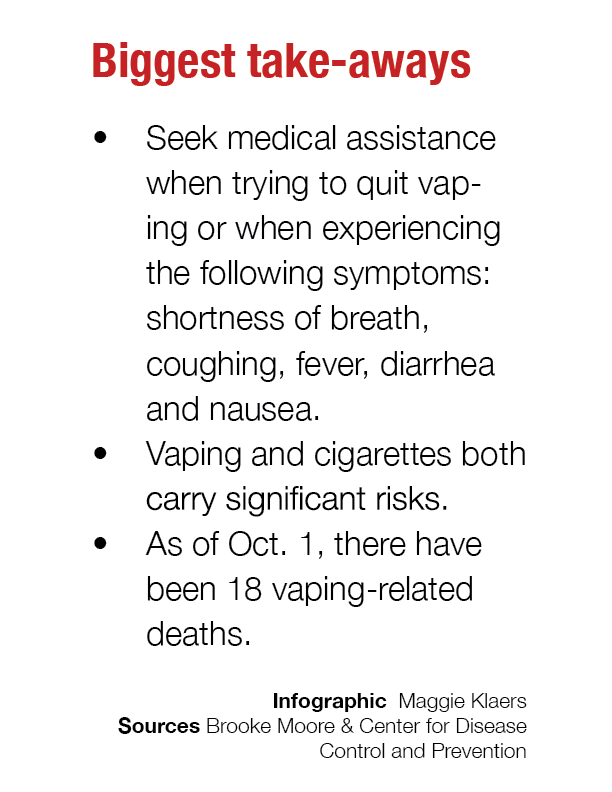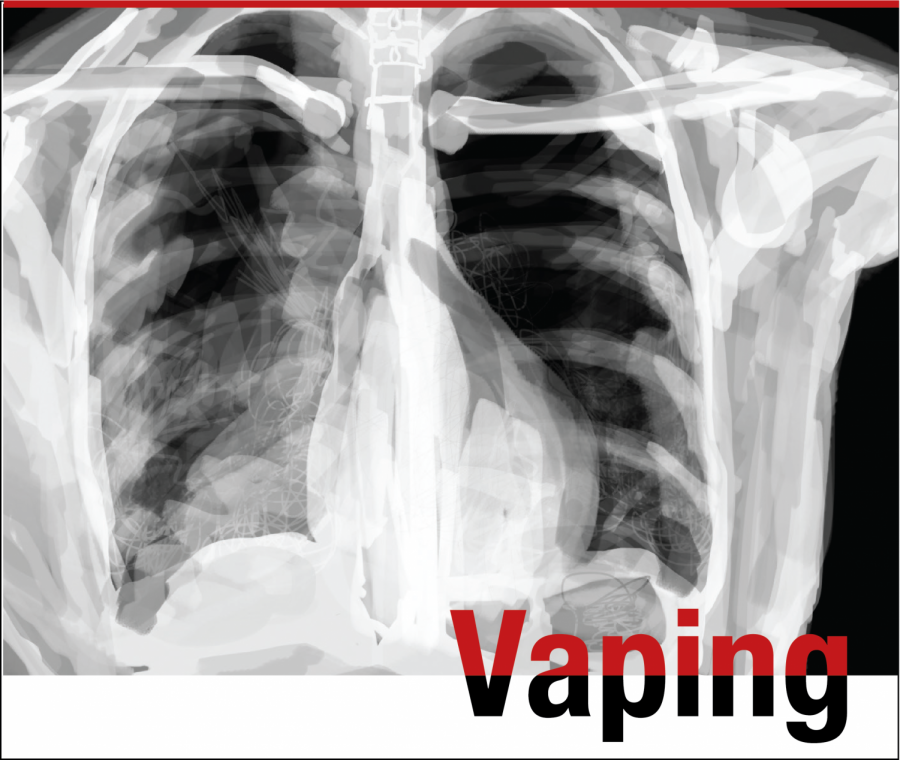Vaping can lead to serious pulmonary illnesses
Over 1,000 reported cases of vaping-related diseases
Art by Maggie Klaers. According to pediatric lung specialist Dr. Brooke Moore, when looking at an x-ray of healthy lungs, the lungs should appear dark black, as they are filled with air. However, as of Oct. 1, over 1000 cases of a vaping-related illness have been reported. This illness causes otherwise healthy teens to present with pneumonia-like x-rays. White fluffy clouds of inflammation replace the black coloration of air in the x-ray.
October 9, 2019
Years ago, senior Quentin Cloutier said he began vaping, but noticed adverse effects as his dependence on nicotine grew.
“I was 16 when I started (vaping). I’ve been doing it for a really long time,” Cloutier said. “It’s for the buzz effect, honestly. It’s a stress reliever, but it’s also really bad. It can hinder your abilities and focus, and can make it difficult to go 15 minutes without needing it — it’s extremely addictive.”
According to pediatric lung specialist Dr. Brooke Moore at Children’s Minnesota Hospital, the effects of vaping resemble the inflammation of the lungs caused by pneumonia.
“There seems to be some chemical in the vaping material causing irritation and inflammation in the lungs. That causes a bunch of white blood cells to flood into the lungs, causing more inflammation,” Moore said. “Patients are presenting with what looks like pneumonia in both lungs, but their infectious workup is negative.”
At the time of the interview, Moore said Children’s had seen 15 patients presenting with this lung disease and required breathing support.
“Some (patients) have needed large flows of oxygen, several of them being on a ventilator or respirator,” Moore said. “One patient went on ECMO (extracorporeal membrane oxygenation). It’s basically a bypass machine where all the blood comes out of your body, goes into an oxygenator and then goes back into your body because the lungs are so sick,” Moore said.
According to Moore, the variety of chemicals vape users consume make it difficult to nail down the cause of the illness.
“The problem is (vape products) don’t all contain the same substances,” Moore said. “Commercially based nicotine products are regulated by the Food and Drug Administration, but they still have different substances in them, depending on what the flavor is.”
Cloutier said temptations have challenged his efforts to quit vaping, but he has learned how to overcome these difficulties.
“I’ve been trying to (quit) for the last week. I’ve been working really hard on it, but once you’re hooked, you’re hooked,” Cloutier said. “There’s been times where I’ve just wanted to (vape), but I can’t. I rub my palm with my thumb and twist it. Deep breaths help, so does trying to focus on something other than the thing that’s bugging you at the moment.”
For those attempting to quit, Moore suggests users speak with their physician.
“If people are using nicotine-based products, in addition to the marijuana-based products, there can be a pretty high level addiction. They may need to seek medical support to quit without having significant nicotine withdrawal,” Moore said.
Moore said it is a misconception that vaping is a harmless replacement for cigarettes.
“When e-cigarettes came on the market, there was a sense they would help people quit using tobacco products and were touted as a safe alternative,” Moore said. “The problem is, they’ve only been on the market for less than 10 years. Just because there’s no data prior to the last few months of adverse effects, doesn’t mean they’re not bad — it just means we didn’t have any data.”
It is important, Cloutier said, to recognize the dangers of vaping.
“For people who are currently vaping, see what it’s doing to your health, and for people who are trying to quit, good (for) you,” Cloutier said. “If you’re going to vape, at least understand that you have the possibility of dying.”





